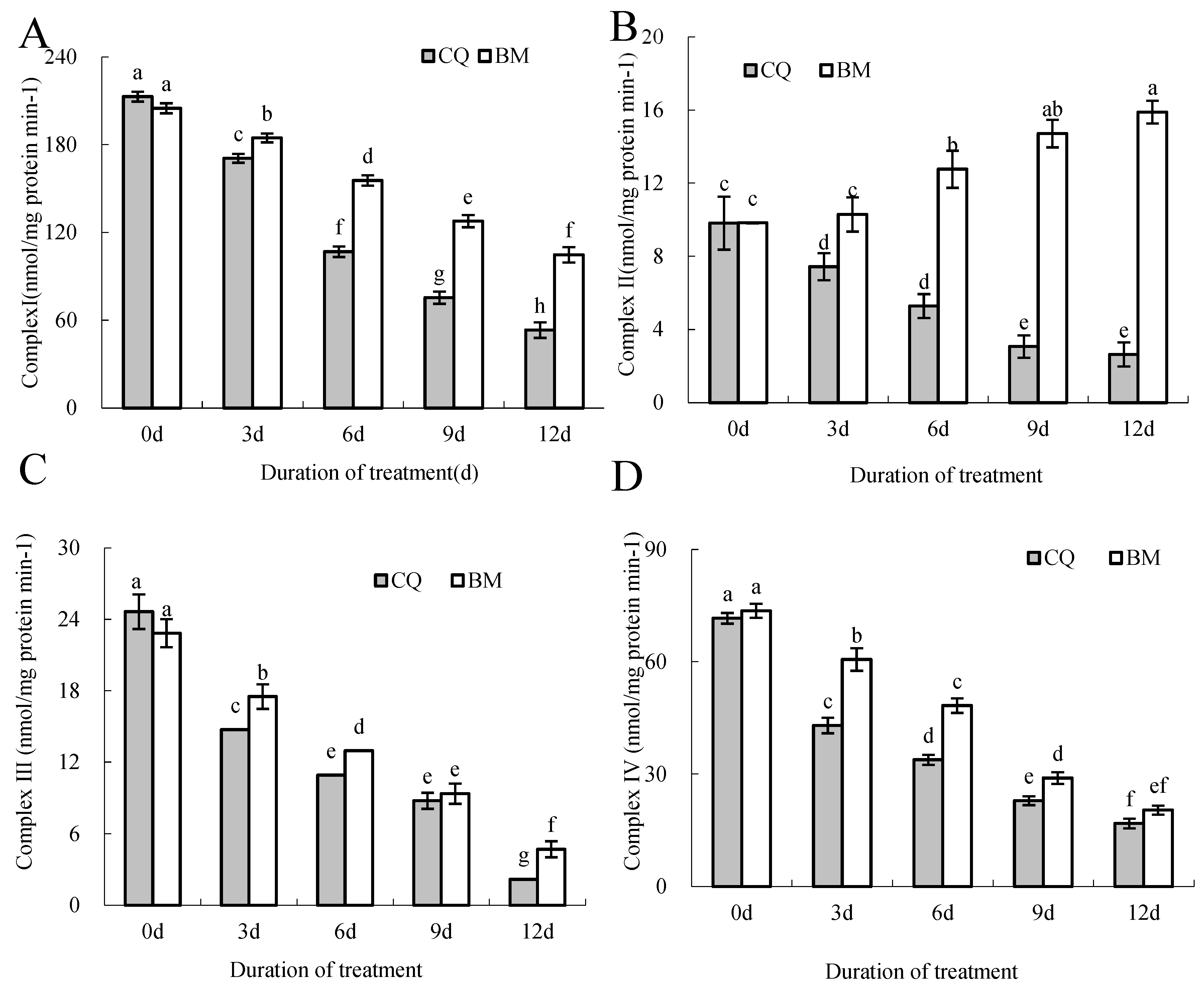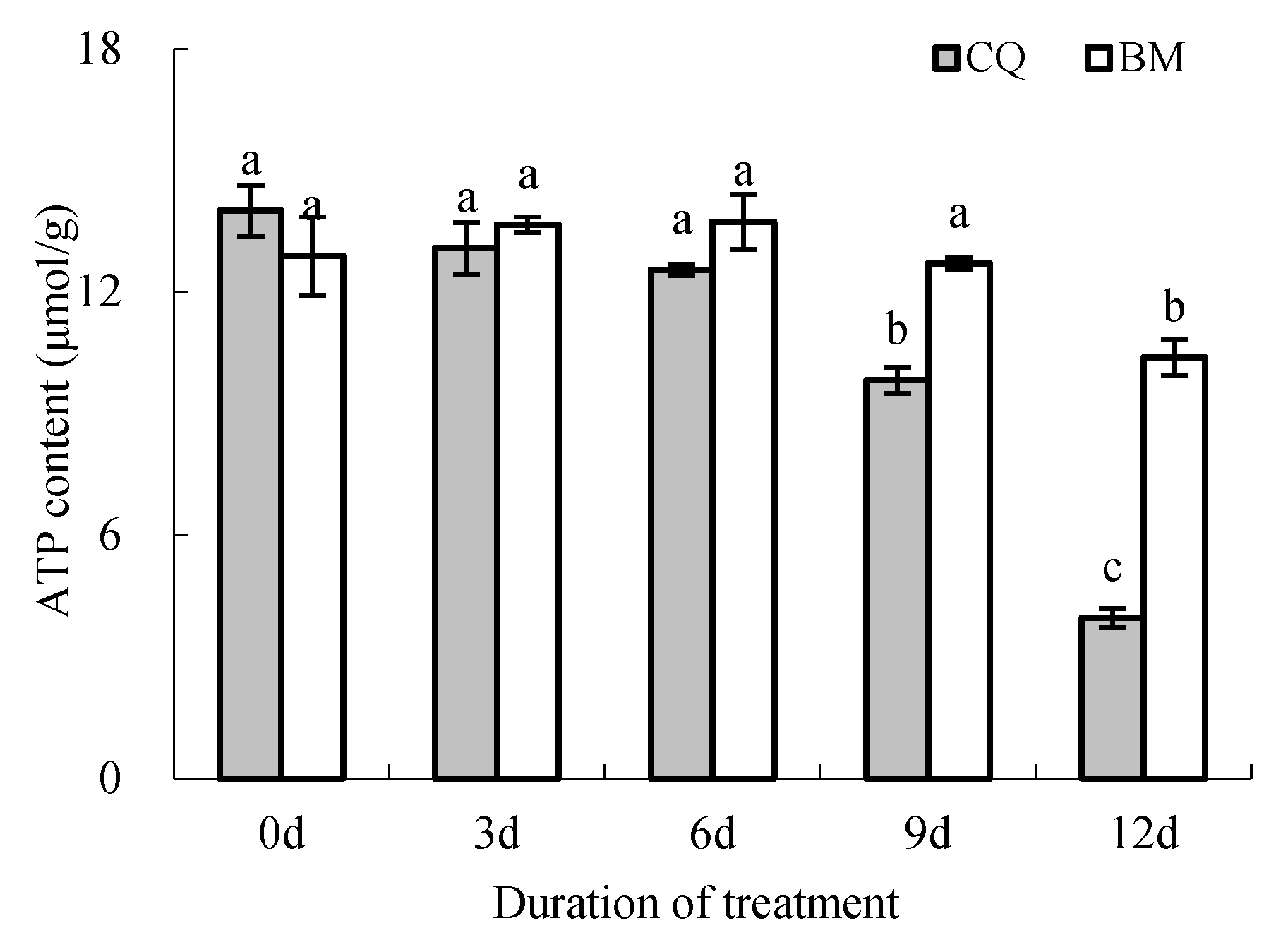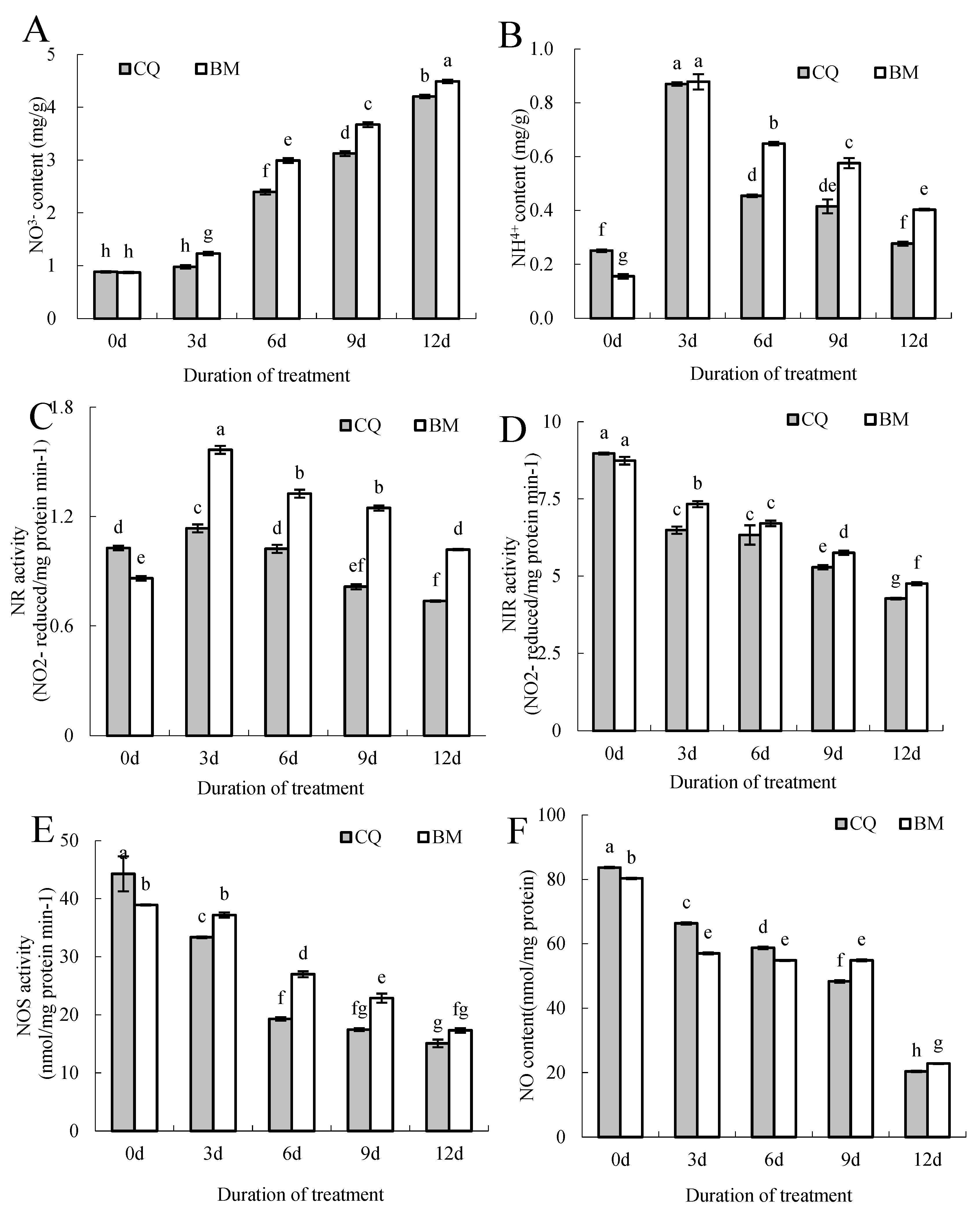Effects of Ca(NO3)2 Stress on Mitochondria and Nitrogen Metabolism in Roots of Cucumber Seedlings
Abstract
1. Introduction
2. Materials and Methods
2.1. Plant Materials and Growth Conditions
2.2. Analyses of Root Morphology and Mitochondria Extraction
2.3. Ultrastructure of Root Tips Cell
2.4. Determination of Mitochondrial Lipid Peroxidation, Mitochondrial Free Radical Production, Mitochondrial H2O2 Level, and Antioxidant Enzyme Activity
2.5. Determination of Mitochondrial Enzyme Activities and Mitochondrial Membrane Properties
2.6. Determination of NH4+, NO3− Concentrations, and Enzyme Activity Involved in N Assimilation
2.7. Statistical Analysis
3. Results
3.1. Root Morphology
3.2. Content of Lipid Peroxides, Free Radical Production, and Antioxidant Enzyme Activity in Mitochondria
3.3. Ca(NO3)2 Effects on Electron Transport Chain in Mitochondria
3.4. MPTP Opening, Membrane Fluidity, Membrane Potential, and ATP Level
3.5. Effects of Ca(NO3)2 on NO3−, NH4+ Content, and NR and NiR Enzyme Activity
3.6. NO Content and NOS Activity
4. Discussion
Supplementary Materials
Author Contributions
Funding
Conflicts of Interest
References
- Fan, H.F.; Ding, L.; Xu, Y.L.; Du, C.X. Seed germination, seedling growth and antioxidant system responses in cucumber exposed to Ca(NO3)2. Hortic. Environ. Biotechnol. 2017, 58, 548–559. [Google Scholar] [CrossRef]
- Chu, S.; Zhang, D.; Wang, D.; Zhi, Y.; Zhou, P. Heterologous expression and biochemical characterization of assimilatory nitrate and nitrite reductase reveals adaption and potential of Bacillus megaterium NCT-2 in secondary salinization soil. Int. J. Biol. Macromol. 2017, 101, 1019–1028. [Google Scholar] [CrossRef]
- Dong, Y.J.; Wang, W.W.; Hu, G.Q.; Chen, W.F.; Zhuge, Y.; Wang, Z.L.; He, M.R. Role of exogenous 24-epibrassinolide in enhancing the salt tolerance of wheat seedlings. J. Soil Sci. Plant Nutr. 2017, 17, 554–569. [Google Scholar] [CrossRef]
- Yuan, L.; Zhu, S.; Shu, S.; Sun, J.; Guo, S. Regulation of 2,4-epibrassinolide on mineral nutrient uptake and ion distribution in Ca(NO3)2 stressed cucumber plants. J. Plant Physiol. 2015, 188, 29–36. [Google Scholar] [CrossRef] [PubMed]
- Yuan, L.; Shu, S.; Sun, J.; Guo, S.; Tezuka, T. Effects of 24-epibrassinolide on the photosynthetic characteristics, antioxidant system, and chloroplast ultrastructure in Cucumis sativus L. under Ca(NO3)2 stress. Photosynth. Res. 2012, 112, 205–214. [Google Scholar] [CrossRef] [PubMed]
- Che-Othman, M.H.; Millar, A.H.; Taylor, N.L. Connecting salt stress signalling pathways with salinity-induced changes in mitochondrial metabolic processes in C3 plants. Plant Cell Env. 2017, 40, 2875–2905. [Google Scholar] [CrossRef]
- Belt, K.; Huang, S.; Thatcher, L.F.; Casarotto, H.; Singh, K.B.; Van Aken, O.; Millar, A.H. Salicylic Acid-Dependent Plant Stress Signaling via Mitochondrial Succinate Dehydrogenase. Plant Physiol. 2017, 173, 2029–2040. [Google Scholar] [CrossRef]
- Jacoby, R.P.; Che-Othman, M.H.; Millar, A.H.; Taylor, N.L. Analysis of the sodium chloride-dependent respiratory kinetics of wheat mitochondria reveals differential effects on phosphorylating and non-phosphorylating electron transport pathways. Plant Cell Env. 2016, 39, 823–833. [Google Scholar] [CrossRef]
- An, Y.; Zhou, H.; Zhong, M.; Sun, J.; Shu, S.; Shao, Q.; Guo, S. Root proteomics reveals cucumber 24-epibrassinolide responses under Ca(NO3)2 stress. Plant Cell Rep. 2016, 35, 1081–1101. [Google Scholar] [CrossRef]
- Zhang, R.; Sun, Y.; Liu, Z.; Jin, W.; Sun, Y. Effects of melatonin on seedling growth, mineral nutrition, and nitrogen metabolism in cucumber under nitrate stress. J. Pineal Res. 2017, 62. [Google Scholar] [CrossRef]
- Kim, Y.; Kim, S.; Shim, I.S. Exogenous salicylic acid alleviates salt-stress damage in cucumber under moderate nitrogen conditions by controlling endogenous salicylic acid levels. Hortic. Environ. Biotechnol. 2017, 58, 247–253. [Google Scholar] [CrossRef]
- Kuhn, K.; Richter, U.; Meyer, E.H.; Delannoy, E.; de Longevialle, A.F.; O’Toole, N.; Borner, T.; Millar, A.H.; Small, I.D.; Whelan, J. Phage-type RNA polymerase RPOTmp performs gene-specific transcription in mitochondria of Arabidopsis thaliana. Plant Cell 2009, 21, 2762–2779. [Google Scholar] [CrossRef] [PubMed]
- Yuan, L.Y.; Liu, S.; Zhu, S.D.; Chen, G.H.; Liu, F.; Zou, M.Q.; Wang, C.G. Comparative response of two wucai (Brassica campestris L.) genotypes to heat stress on antioxidative system and cell ultrastructure in root. Acta Physiol. Plant. 2016, 38, 223. [Google Scholar] [CrossRef]
- Heath, R.L.; Packer, L. Photoperoxidation in isolated chloroplasts. I. Kinetics and stoichiometry of fatty acid peroxidation. Arch. Biochem. Biophys. 1968, 125, 189–198. [Google Scholar] [CrossRef]
- Rauckman, E.J.; Rosen, G.M.; Kitchell, B.B. Superoxide radical as an intermediate in the oxidation of hydroxylamines by mixed function amine oxidase. Mol. Pharmacol. 1979, 15, 131–137. [Google Scholar] [PubMed]
- Giannopolitis, C.N.; Ries, S.K. Superoxide dismutases: I. Occurrence in higher plants. Plant Physiol 1977, 59, 309–314. [Google Scholar] [CrossRef]
- Rao, M.V.; Paliyath, G.; Ormrod, D.P. Ultraviolet-B- and ozone-induced biochemical changes in antioxidant enzymes of Arabidopsis thaliana. Plant Physiol. 1996, 110, 125–136. [Google Scholar] [CrossRef]
- Dhindsa, R.S.; Plumb-Dhindsa, P.; Thorpe, T.A. Leaf Senescence: Correlated with Increased Levels of Membrane Permeability and Lipid Peroxidation, and Decreased Levels of Superoxide Dismutase and Catalase. J. Exp. Bot. 1981, 32, 93–101. [Google Scholar] [CrossRef]
- Yuan, L.; Zhang, J.; Liu, Y.; Zhao, J.; Jiang, F.; Liu, Y. Indium (III) induces isolated mitochondrial permeability transition by inhibiting proton influx and triggering oxidative stress. J. Inorg. Biochem. 2017, 177, 17–26. [Google Scholar] [CrossRef]
- Wang, L.L.; Han, L.; Ma, X.L.; Yu, Q.L.; Zhao, S.N. Effect of mitochondrial apoptotic activation through the mitochondrial membrane permeability transition pore on yak meat tenderness during postmortem aging. Food Chem. 2017, 234, 323–331. [Google Scholar] [CrossRef]
- Huang, P.; Li, G.; Chen, C.; Wang, H.; Han, Y.; Zhang, S.; Xiao, Y.; Zhang, M.; Liu, N.; Chu, J.; et al. Differential toxicity of Mn2+ and Mn3+ to rat liver tissues: Oxidative damage, membrane fluidity and histopathological changes. Exp. Toxicol. Pathol. 2012, 64, 197–203. [Google Scholar] [CrossRef] [PubMed]
- Meng, S.; Zhang, C.X.; Su, L.; Li, Y.M.; Zhao, Z. Nitrogen uptake and metabolism of Populus simonii in response to PEG-induced drought stress. Environ. Exp. Bot. 2016, 123, 78–87. [Google Scholar] [CrossRef]
- Liu, L.; Xiao, W.; Li, L.; Li, D.M.; Gao, D.S.; Zhu, C.Y.; Fu, X.L. Effect of exogenously applied molybdenum on its absorption and nitrate metabolism in strawberry seedlings. Plant Physiol. Biochem. 2017, 115, 200–211. [Google Scholar] [CrossRef] [PubMed]
- Stolarz, M.; Dziubinska, H. Osmotic and Salt Stresses Modulate Spontaneous and Glutamate-Induced Action Potentials and Distinguish between Growth and Circumnutation in Helianthus annuus Seedlings. Front. Plant Sci. 2017, 8, 1766. [Google Scholar] [CrossRef] [PubMed]
- Zhang, H.; Liu, X.-L.; Zhang, R.-X.; Yuan, H.-Y.; Wang, M.-M.; Yang, H.-Y.; Ma, H.-Y.; Liu, D.; Jiang, C.-J.; Liang, Z.-W. Root Damage under Alkaline Stress Is Associated with Reactive Oxygen Species Accumulation in Rice (Oryza sativa L.). Front. Plant Sci. 2017, 8. [Google Scholar] [CrossRef]
- Tamas, L.; Zelinova, V. Mitochondrial complex II-derived superoxide is the primary source of mercury toxicity in barley root tip. J. Plant Physiol. 2017, 209, 68–75. [Google Scholar] [CrossRef]
- Gharbi, E.; Martinez, J.P.; Benahmed, H.; Hichri, I.; Dobrev, P.I.; Motyka, V.; Quinet, M.; Lutts, S. Phytohormone profiling in relation to osmotic adjustment in NaCl-treated plants of the halophyte tomato wild relative species Solanum chilense comparatively to the cultivated glycophyte Solanum lycopersicum. Plant Sci. 2017, 258, 77–89. [Google Scholar] [CrossRef]
- Fan, Y.; Tian, Z.; Yan, Y.; Hu, C.; Abid, M.; Jiang, D.; Ma, C.; Huang, Z.; Dai, T. Winter Night-Warming Improves Post-anthesis Physiological Activities and Sink Strength in Relation to Grain Filling in Winter Wheat (Triticum aestivum L.). Front. Plant Sci. 2017, 8, 992. [Google Scholar] [CrossRef]
- Liu, Q.; Xi, Z.; Gao, J.; Meng, Y.; Lin, S.; Zhang, Z. Effects of exogenous 24-epibrassinolide to control grey mould and maintain postharvest quality of table grapes. Int. J. Food Sci. Technol. 2016, 51, 1236–1243. [Google Scholar] [CrossRef]
- Ju, S.; Wang, L.; Yin, N.; Li, D.; Wang, Y.; Zhang, C. Silicon alleviates simulated acid rain stress of Oryza sativa L. seedlings by adjusting physiology activity and mineral nutrients. Protoplasma 2017, 254, 2071–2081. [Google Scholar] [CrossRef]
- Zhang, W.; Xie, Z.; Wang, L.; Li, M.; Lang, D.; Zhang, X. Silicon alleviates salt and drought stress of Glycyrrhiza uralensis seedling by altering antioxidant metabolism and osmotic adjustment. J. Plant. Res. 2017, 130, 611–624. [Google Scholar] [CrossRef]
- Tamas, L.; Mistrik, I.; Zelinova, V. Cadmium activates both diphenyleneiodonium- and rotenone-sensitive superoxide production in barley root tips. Planta 2016, 244, 1277–1287. [Google Scholar] [CrossRef]
- Restovic, F.; Espinoza-Corral, R.; Gomez, I.; Vicente-Carbajosa, J.; Jordana, X. An active Mitochondrial Complex II Present in Mature Seeds Contains an Embryo-Specific Iron-Sulfur Subunit Regulated by ABA and bZIP53 and Is Involved in Germination and Seedling Establishment. Front. Plant. Sci. 2017, 8, 277. [Google Scholar] [CrossRef] [PubMed]
- Huang, S.; Lee, C.P.; Millar, A.H. Activity assay for plant mitochondrial enzymes. Methods Mol. Biol 2015, 1305, 139–149. [Google Scholar] [CrossRef] [PubMed]
- Schikowsky, C.; Senkler, J.; Braun, H.P. SDH6 and SDH7 Contribute to Anchoring Succinate Dehydrogenase to the Inner Mitochondrial Membrane in Arabidopsis thaliana. Plant. Physiol 2017, 173, 1094–1108. [Google Scholar] [CrossRef] [PubMed]
- Jardim-Messeder, D.; Caverzan, A.; Rauber, R.; de Souza Ferreira, E.; Margis-Pinheiro, M.; Galina, A. Succinate dehydrogenase (mitochondrial complex II) is a source of reactive oxygen species in plants and regulates development and stress responses. New Phytol 2015, 208, 776–789. [Google Scholar] [CrossRef]
- Zhen, A.; Zhang, Z.; Jin, X.; Liu, T.; Ren, W.; Hu, X. Exogenous GABA application improves the NO3− −N absorption and assimilation in Ca(NO3)2 -treated muskmelon seedlings. Sci. Hortic. 2018, 227, 117–123. [Google Scholar] [CrossRef]
- Li, L.; Shu, S.; Xu, Q.; An, Y.H.; Sun, J.; Guo, S.R. NO accumulation alleviates H2O2-dependent oxidative damage induced by Ca(NO3)2 stress in the leaves of pumpkin-grafted cucumber seedlings. Physiol Plant. 2017, 160, 33–45. [Google Scholar] [CrossRef]
- Du, J.; Shu, S.; An, Y.; Zhou, H.; Guo, S.; Sun, J. Influence of exogenous spermidine on carbon–nitrogen metabolism under Ca(NO3)2 stress in cucumber root. Plant. Growth Regul. 2016, 81, 1–13. [Google Scholar] [CrossRef]
- Igamberdiev, A.U.; Ratcliffe, R.G.; Gupta, K.J. Plant mitochondria: Source and target for nitric oxide. Mitochondrion 2014, 19 Pt B, 329–333. [Google Scholar] [CrossRef]





| Length (cm) | Surface Area (cm2) | Average Diam (mm) | Tips | |||||
|---|---|---|---|---|---|---|---|---|
| Chunqiu (CQ) | BoMei 49 (BM) | CQ | BM | CQ | BM | CQ | BM | |
| 0 days | 546.63 ± 12.67b | 609.30 ± 12.24a | 148.59 ± 3.18cd | 203.86 ± 1.45a | 0.8219 ± 0.0096c | 0.9222 ± 0.0295de | 3586.67 ± 124.23b | 4064.00 ± 75.50a |
| 3 days | 405.86 ± 23.50cd | 522.01 ±46.02b | 153.25 ± 2.66c | 184.51 ± 6.75b | 1.1292 ± 0.0677cd | 1.1423 ± 0.0750cd | 1609.00 ±153.62d | 2301.00 ± 6.08c |
| 6 days | 392.25 ± 16.65cd | 500.26 ± 4.02b | 153.22 ± 6.64c | 154.22 ± 4.63c | 1.1630 ± 0.0474cd | 1.5013 ± 0.0943b | 1756.33 ± 86.78d | 1676.67 ± 33.46d |
| 9 days | 346.63 ± 2.22d | 413.50 ± 15.05c | 157.53 ± 7.83c | 138.55 ± 2.30d | 1.4002 ± 0.0309bc | 1.5480 ± 0.0636b | 902.00 ± 43.66e | 1000.00 ± 44.8e |
| 12 days | 185.10 ±10.03e | 234.11 ±21.55e | 85.35 ± 6.27e | 136.79 ± 4.47d | 1.4844 ± 0.1791b | 2.2367 ± 0.1365a | 794.33 ± 18.187e | 849.33 ± 69.29e |
| MDA (μmol/g Protein) | H2O2 (μmol/g Protein) | O2-Generation Rate (μmol/g·min−1 Protein) | ||||
|---|---|---|---|---|---|---|
| CQ | BM | CQ | BM | CQ | BM | |
| 0 days | 0.7368 ± 0.0171g | 0.6480 ± 0.01671h | 51.33 ± 1.034i | 55.65 ± 0.81i | 0.2209 ± 0.0075d | 0.1472 ± 0.0089e |
| 3 days | 1.9701 ± 0.0050e | 1.7591 ± 0.03220f | 107.51 ± 0.55f | 73.25 ± 1.05h | 0.2736 ± 0.0018c | 0.2452 ± 0.0029d |
| 6 days | 2.3557 ± 0.0465c | 2.2407 ± 0.01835d | 139.71 ± 3.54d | 90.46 ± 0.27g | 0.3296 ± 0.0074b | 0.2851 ± 0.0234c |
| 9 days | 3.1500 ± 0.0064b | 2.2382 ± 0.0110d | 170.87 ± 3.11b | 115.81 ± 1.15e | 0.4952 ± 0.0058a | 0.3318 ± 0.0036b |
| 12 days | 3.5217 ± 0.03362a | 2.2667 ± 0.0239d | 191.77 ± 5.69a | 150.13 ± 0.91c | 0.5059 ± 0.0029a | 0.3200 ± 0.0030ab |
| Cytochrome c/a | MPTP Opening | Membrane Fluidity | Membrane Potential | |||||
|---|---|---|---|---|---|---|---|---|
| CQ | BM | CQ | BM | CQ | BM | CQ | BM | |
| 0 days | 1.1854 ± 0.0038a | 1.1455 ± 0.0065a | 0.2213 ± 0.0127c | 0.2467 ± 0.0107d | 39.65 ± 0.18a | 41.15 ± 0.12a | 20.96 ± 0.10a | 25.09 ± 0.34a |
| 3 days | 1.0091 ± 0.0002b | 1.0367 ± 0.0094b | 0.7040 ± 0.0069a | 0.5287 ± 0.0068c | 26.93 ± 0.03b | 33.13 ± 1.12b | 12.65 ± 0.52b | 18.01 ± 0.58b |
| 6 days | 0.9979 ± 0.0030b | 1.0171 ± 0.0044c | 0.6733± 0.0176ab | 0.5487 ± 0.0192bc | 22.36 ± 0.36c | 30.27 ± 0.35c | 11.82 ± 0.12c | 16.27 ± 0.83c |
| 9 days | 0.9639 ± 0.0082c | 0.9979 ± 0.0007d | 0.6627 ± 0.0013b | 0.5873 ± 0.0064a | 20.87 ± 0.30d | 28.63 ± 0.30cd | 10.02 ± 0.08d | 14.74 ± 0.27c |
| 12 days | 0.9180 ± 0.0090d | 0.9493 ± 0.0038e | 0.6567 ± 0.0033b | 0.5787 ± 0.0047ab | 20.24 ± 0.23d | 27.53 ± 0.75d | 8.55 ± 0.05e | 12.85 ± 0.07d |
© 2020 by the authors. Licensee MDPI, Basel, Switzerland. This article is an open access article distributed under the terms and conditions of the Creative Commons Attribution (CC BY) license (http://creativecommons.org/licenses/by/4.0/).
Share and Cite
Yang, Y.; Lu, Z.; Li, J.; Tang, L.; Jia, S.; Feng, X.; Wang, C.; Yuan, L.; Hou, J.; Zhu, S. Effects of Ca(NO3)2 Stress on Mitochondria and Nitrogen Metabolism in Roots of Cucumber Seedlings. Agronomy 2020, 10, 167. https://doi.org/10.3390/agronomy10020167
Yang Y, Lu Z, Li J, Tang L, Jia S, Feng X, Wang C, Yuan L, Hou J, Zhu S. Effects of Ca(NO3)2 Stress on Mitochondria and Nitrogen Metabolism in Roots of Cucumber Seedlings. Agronomy. 2020; 10(2):167. https://doi.org/10.3390/agronomy10020167
Chicago/Turabian StyleYang, Yang, Zhiyuan Lu, Jie Li, Ling Tang, Shaoke Jia, Xuming Feng, Chenggang Wang, Lingyun Yuan, Jinfeng Hou, and Shidong Zhu. 2020. "Effects of Ca(NO3)2 Stress on Mitochondria and Nitrogen Metabolism in Roots of Cucumber Seedlings" Agronomy 10, no. 2: 167. https://doi.org/10.3390/agronomy10020167
APA StyleYang, Y., Lu, Z., Li, J., Tang, L., Jia, S., Feng, X., Wang, C., Yuan, L., Hou, J., & Zhu, S. (2020). Effects of Ca(NO3)2 Stress on Mitochondria and Nitrogen Metabolism in Roots of Cucumber Seedlings. Agronomy, 10(2), 167. https://doi.org/10.3390/agronomy10020167





